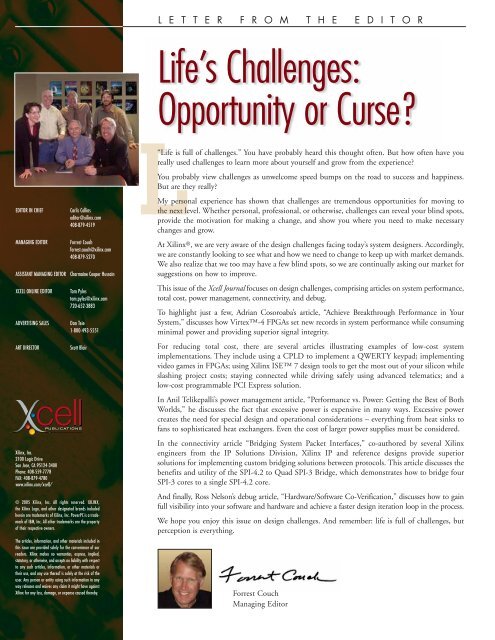Design Challenges: Avoiding the Pitfalls, winning the game - Xilinx
Design Challenges: Avoiding the Pitfalls, winning the game - Xilinx
Design Challenges: Avoiding the Pitfalls, winning the game - Xilinx
Create successful ePaper yourself
Turn your PDF publications into a flip-book with our unique Google optimized e-Paper software.
EDITOR IN CHIEF Carlis Collins<br />
editor@xilinx.com<br />
408-879-4519<br />
MANAGING EDITOR Forrest Couch<br />
forrest.couch@xilinx.com<br />
408-879-5270<br />
ASSISTANT MANAGING EDITOR Charmaine Cooper Hussain<br />
XCELL ONLINE EDITOR Tom Pyles<br />
tom.pyles@xilinx.com<br />
720-652-3883<br />
ADVERTISING SALES Dan Teie<br />
1-800-493-5551<br />
ART DIRECTOR Scott Blair<br />
<strong>Xilinx</strong>, Inc.<br />
2100 Logic Drive<br />
San Jose, CA 95124-3400<br />
Phone: 408-559-7778<br />
FAX: 408-879-4780<br />
www.xilinx.com/xcell/<br />
© 2005 <strong>Xilinx</strong>, Inc. All rights reserved. XILINX,<br />
<strong>the</strong> <strong>Xilinx</strong> Logo, and o<strong>the</strong>r designated brands included<br />
herein are trademarks of <strong>Xilinx</strong>, Inc. PowerPC is a trademark<br />
of IBM, Inc. All o<strong>the</strong>r trademarks are <strong>the</strong> property<br />
of <strong>the</strong>ir respective owners.<br />
The articles, information, and o<strong>the</strong>r materials included in<br />
this issue are provided solely for <strong>the</strong> convenience of our<br />
readers. <strong>Xilinx</strong> makes no warranties, express, implied,<br />
statutory, or o<strong>the</strong>rwise, and accepts no liability with respect<br />
to any such articles, information, or o<strong>the</strong>r materials or<br />
<strong>the</strong>ir use, and any use <strong>the</strong>reof is solely at <strong>the</strong> risk of <strong>the</strong><br />
user. Any person or entity using such information in any<br />
way releases and waives any claim it might have against<br />
<strong>Xilinx</strong> for any loss, damage, or expense caused <strong>the</strong>reby.<br />
L E T T E R F R O M T H E E D I T O R<br />
Life’s <strong>Challenges</strong>:<br />
Opportunity or Curse?<br />
L“Life is full of challenges.” You have probably heard this thought often. But how often have you<br />
really used challenges to learn more about yourself and grow from <strong>the</strong> experience?<br />
You probably view challenges as unwelcome speed bumps on <strong>the</strong> road to success and happiness.<br />
But are <strong>the</strong>y really?<br />
My personal experience has shown that challenges are tremendous opportunities for moving to<br />
<strong>the</strong> next level. Whe<strong>the</strong>r personal, professional, or o<strong>the</strong>rwise, challenges can reveal your blind spots,<br />
provide <strong>the</strong> motivation for making a change, and show you where you need to make necessary<br />
changes and grow.<br />
At <strong>Xilinx</strong> ®, we are very aware of <strong>the</strong> design challenges facing today’s system designers. Accordingly,<br />
we are constantly looking to see what and how we need to change to keep up with market demands.<br />
We also realize that we too may have a few blind spots, so we are continually asking our market for<br />
suggestions on how to improve.<br />
This issue of <strong>the</strong> Xcell Journal focuses on design challenges, comprising articles on system performance,<br />
total cost, power management, connectivity, and debug.<br />
To highlight just a few, Adrian Cosoroaba’s article, “Achieve Breakthrough Performance in Your<br />
System,” discusses how Virtex-4 FPGAs set new records in system performance while consuming<br />
minimal power and providing superior signal integrity.<br />
For reducing total cost, <strong>the</strong>re are several articles illustrating examples of low-cost system<br />
implementations. They include using a CPLD to implement a QWERTY keypad; implementing<br />
video <strong>game</strong>s in FPGAs; using <strong>Xilinx</strong> ISE 7 design tools to get <strong>the</strong> most out of your silicon while<br />
slashing project costs; staying connected while driving safely using advanced telematics; and a<br />
low-cost programmable PCI Express solution.<br />
In Anil Telikepalli’s power management article, “Performance vs. Power: Getting <strong>the</strong> Best of Both<br />
Worlds,” he discusses <strong>the</strong> fact that excessive power is expensive in many ways. Excessive power<br />
creates <strong>the</strong> need for special design and operational considerations – everything from heat sinks to<br />
fans to sophisticated heat exchangers. Even <strong>the</strong> cost of larger power supplies must be considered.<br />
In <strong>the</strong> connectivity article “Bridging System Packet Interfaces,” co-authored by several <strong>Xilinx</strong><br />
engineers from <strong>the</strong> IP Solutions Division, <strong>Xilinx</strong> IP and reference designs provide superior<br />
solutions for implementing custom bridging solutions between protocols. This article discusses <strong>the</strong><br />
benefits and utility of <strong>the</strong> SPI-4.2 to Quad SPI-3 Bridge, which demonstrates how to bridge four<br />
SPI-3 cores to a single SPI-4.2 core.<br />
And finally, Ross Nelson’s debug article, “Hardware/Software Co-Verification,” discusses how to gain<br />
full visibility into your software and hardware and achieve a faster design iteration loop in <strong>the</strong> process.<br />
We hope you enjoy this issue on design challenges. And remember: life is full of challenges, but<br />
perception is everything.<br />
Forrest Couch<br />
Managing Editor

















